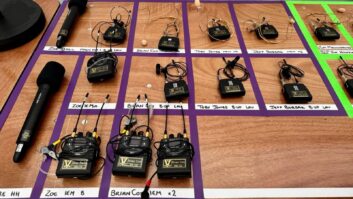With Grand Slam tennis’ ability to throw up so many intriguing storylines, rights holders need the freedom to be able to go wherever the action is happening on-site. Whether on the main show court, in the VIP areas or out in the fan village, there is a lot of acreage to cover. And with the growing need for more original and engaging content to fill broadcast schedules on a range of platforms, as well as provide material for social media use, it’s no longer just the two-week tournament that is filmed, it’s also the week-long qualification process that proceeds it.
Radio frequency (RF) technology provides the ideal solution for getting in amongst the action, and delivering something original beyond the host or world feeds. Rights holders turn to wireless cameras to enable them to deliver a more creative production for their viewers. These tools give them the freedom to do a range of treatments including live to cameras, interviews and even guided tours. The trouble is though, that RF is a complicated technology to manage, particularly in built-up urban environments like Melbourne, Paris, London or New York, where Grand Slam tennis takes place. The last thing the end user wants is to have this creative freedom curtailed by the need for manual intervention from RF engineers when they’re ready to go and shoot.
So how do you go about delivering faultless RF in such challenging locations and during such high-profile events? The key, as with most things, is in the preparation.
Site visits at the beginning of a project planning stage are absolutely essential, no matter how many times you’ve worked at that location previously. Some deployments can have up to 30 antennas within the receiver network, all strategically located, to ensure site-wide coverage. And with major sporting venues or the surrounding areas likely to have changed to some degree since the last visit, it’s important to start afresh each time.

Frequency management is the next stage, and one that requires an in-depth knowledge of the environment and experience of working with the authority that manages the local spectrum allocation. Securing the preferred frequency band to operate within is not always easy, and can change from year-to-year especially somewhere like New York where there is a lot of competition for space. You also have to be prepared to deal with unlicensed intruders that may encroach in your space, so you need to have redundancy through spare frequencies that you can move to if you are experiencing interference. The more flexible your approach the better.
All of the RF equipment should be pre-configured to the agreed specifications prior to shipping, which reduces rig-time on site and also ensures any faults can be identified and fixed. There is also a significant logistical operation required to ensure every item needed arrives in the right place at the right time.
Once the rig is complete, the RF vendor should be available at all times, but invisible to the rights holder, with only the batteries needing changing during the operational deployment time. The service should be seamless, with the broadcaster able to go where they want, when they want in order to make the content that they want. Success is all down to the quality of the preparation, clever use of the technology and the expertise you are able to call on.







